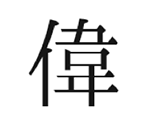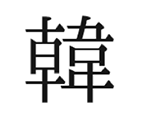178. The "Tanned Leather" Radical: 韋
The 韋 radical throws us some curveballs, but before we address those, I'll present simpler facts.
Henshall says in his newer edition that 韋 originally represented "go in different directions" or "move away from."
This radical is on duty in just one Joyo kanji:
韓 (1981: South Korea)
Several Joyo characters include 韋 as a component:
衛 (617: guard)
偉 (1005: great)
違 (1006: to differ)
緯 (1009: latitude)
If you're wondering about the similar numbers in the last three, Henshall organized his two volumes by yomi and numbered the kanji accordingly, and I borrowed the numbering scheme in his first book for Joy o' Kanji. The phonetic 韋 makes the on-yomi イ echo throughout these three kanji in what I've dubbed an on-echo pattern. (For more on this, see the glossary.) And as I wrote in essay 1009 on 緯, this echoing series includes 囲 (422: to encircle) because the part inside the box used to be 韋, not 井.
Photo Credit: Eve Kushner
A restaurant in the Ginza section of Tokyo specializes in Korean medicinal cooking, as the compounds reflect:
韓国 (かんこく: Korea)
薬膳 (やくぜん: medicinal cooking (usually based on Traditional Chinese Medicine))
The restaurant name is Haiyaku, as shown here in hiragana and romaji. The はい comes from 榛原郡 (はいばらぐん: Haibara District, in which 榛 is non-Joyo), a district in nearby Shizuoka Prefecture. Meanwhile, the やく in はいやく corresponds to 薬 (medicine).
The Name of the 韋 Radical
Here's Curveball 1. Radical names often come from the yomi of the kanji most closely associated with them. As 韓 (1981) has only one Joyo reading, カン, you might expect 韋 to bear the same pronunciation. But no, the Japanese radical name is なめしがわ! You can render that in several ways:
なめし革 or なめし皮 or 鞣し革 or 鞣革 or 鞣皮 (なめしがわ: leather; tanned animal hide; suede)
The 鞣 kanji (which means "tanned leather") is non-Joyo, which explains the hiragana in the first two renderings. Anyway, なめしがわ essentially means "tanned leather," which is also the English radical name.
In both languages the radical name distinguishes 韋 from this one:
radical 177 (革: "leather")
On revisiting that Radical Note, I'm amused to see this at the outset: "I find that it's best to put off challenges as long as possible, so let's start with the easy parts." I wrote the two Radical Notes nine years apart. Apparently, procrastination has been a constant in my life!
A third radical name has thematic overlaps with "leather" and "tanned leather":
radical 107: 皮 ("hide")
In fact, an alternate name for the 皮 radical is "leather," but we'll stick with "hide."
Sticky Stroke Counts
Speaking of that, I can run but I can't hide forever from Curveball 2, which involves the stroke count of radical 178. Traditionally, people have considered 韋 to have 9 strokes, but in 韓, the right side contains 10. How can this be?
One answer is that the standard form of 韓 features a variant of our radical, one with 10 strokes. Compare the lower-left corners of each shape here:


In the left-hand image (the traditional shape), the part resembling ヰ has 3 strokes, drawn in this order:
1. A horizontal stroke
2. An L-shaped stroke right under stroke #1
3. A vertical stroke
In the second image (the variant form), one draws the same segment with 4 strokes:
1. A horizontal stroke
2. A shorter vertical stroke
3. A lower horizontal stroke
4. A longer vertical stroke
The Agency of Cultural Affairs, which issued the Joyo list and controls kanji decisions, uses a font in which the ヰ-like bit has 4 strokes whenever our radical serves as a mere component, as in 衛 (617), 偉 (1005), 違 (1006), and 緯 (1009). Thus, our radical always has 10 strokes in those kanji.
With 韓, however, the stroke count of the radical varies. Compare the ヰ-like part of these images:


The lower-left shapes in 韋 look markedly different, but both have 4 strokes. In 韓 that's true because although the first 2 strokes in the ヰ-like part meet neatly at the top-left corner, you can't round that kind of corner with a continuous stroke. After all, the top horizontal stroke goes from left to right, and then you need to pick up your pen and draw a vertical stroke from top to bottom.
In the agency's font, the ヰ-like part of 韓 again has 4 strokes, with the radical in 韓 having 10 all together. Dictionaries such as Kanjigen treat our radical the same way. But if we change the font, the stroke count of the ヰ-like bit could go down to 3, adding up to 9 for our radical overall, as in the first large image I presented of our radical.
So the traditional 9-stroke shape is rarely seen, whereas the 10-stroke variant is common. A curveball indeed!
For more on how such issues affect other radicals and kanji, see "Sticky Stroke Counts" in Thematic Explorations.
